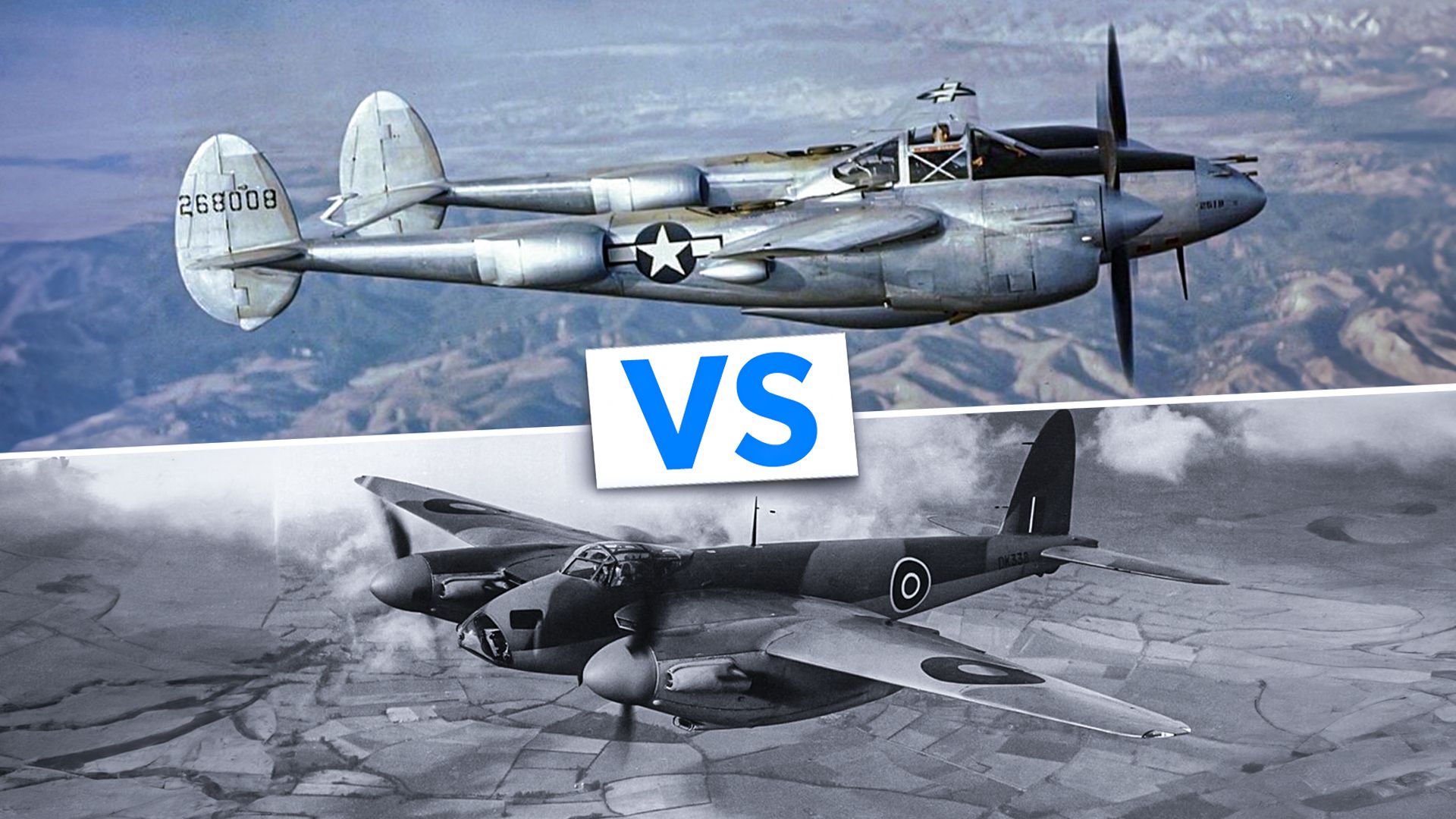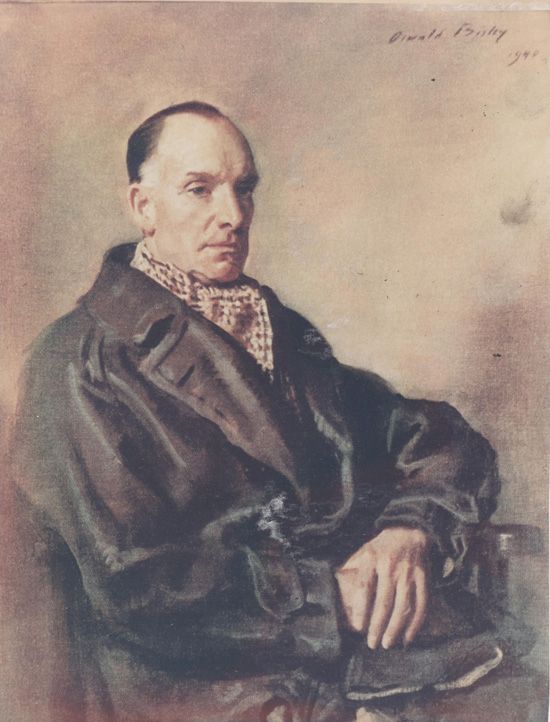Aahh, gotta love the “special relationship” between the United States of America and the United Kingdom of Great Britain and Northern Ireland. Arguably, the greatest demonstration of that special relationship was during the Second World War, when the two nations pooled their manpower and industrial might as part of the Allies against the Axis of Nazi Germany, Imperial Japan, and Fascist Italy.
Not surprisingly, both nations produced some very impressive warbirds to help them defeat the Axis powers, and one subcategory of warbird that the US and UK alike turned out was a legendary top-notch twin-engine propeller-driven fighter plane, In the case of the good ol’ US or A, it was the US Army Air Corps (USAAC; later US Army Air Forces [USAAF]) Lockheed P-38 Lightning, while in the case of jolly ol’ Britain, it was the Royal Air Force (RAF) de Havilland Mosquito. So then, between the Lightning and the Mosquito, which one was the truly “better” fighter? Simple Flying will now attempt to tackle this debate.
Tale of the Tape: P-38 and Mosquito early history and specifications head-to-head
The Lockheed P-38 Lightning made its maiden flight on January 27, 1939, and entered into official operational service with the US Army Air Corps in July 1941. “First conceived in 1937 by Lockheed chief engineer Hall Livingstone Hibbard (July 26, 1903 – June 6, 1996) and his then assistant, Clarence “Kelly” Johnson (February 27, 1910 – December 21, 1990), the latter of whom went on to found Lockheed’s legendary “Skunk Works” division. (And now you know why the Skunk Works F-35 is officially named the Lightning II.)
Meanwhile, the de Havilland DH.98 Mosquito, AKA the “Wooden Wonder” (due to its all-wood construction, unique amongst WWII combat planes) or “Mossie,” made its own maiden flight on November 25, 1940, and officially entered into RAF operational duties on November 15, 1941. It was the brainchild of the late great Captain Sir Geoffrey de Havilland (27 July 1882 – 21 May 1965).
Unlike the P-38, which was designed as a fighter from the ground up (bad pun intended), the Mosquito was initially conceived as a light bomber, tracing those roots back to 1936, when the British Air Ministry issued Specification P.13/36, which called for a twin-engined medium bomber capable of carrying a bomb load of 3,000 lb (1,400 kg) for 3,000 mi (4,800 km) with a maximum speed of 275 mph (445 km/h) at 15,000 ft (4,600 m); a maximum bomb load of 8,000 lb (3,600 kg) carried over shorter ranges was also required.
As for comparative specifications, starting with the Lightning (P-38L variant):
- Max Airspeed: 414 mph (666 km/h, 360 kn)
- Range: 3,300 mi (5,300 km, 2,900 NM)
- Service Ceiling: 44,000 ft (13,000 m)
- Rate of Climb: 4,750 ft/min (24.1 m/s)
-
Armament:
- Guns: 1× Hispano M2(C) 20 mm cannon with 150 rounds; 4× M2 “Ma Deuce” Browning .50 caliber (12.7 mm) machine guns with 500 rounds per gun.
- Bombs: Inner hardpoints with a capacity for 2× 2,000 lb (907 kg) bombs; Outer hardpoints with a capacity of 2× 500 lb (227 kg) bombs
Moving onto the Mosquito (B Mk. XVI variant):
- Max Airspeed: 415 mph (668 km/h, 361 kn) at 28,000 ft (8,500 m)
- Range: 1,955 mi (3,146 km, 1,698 NM)
- Service Ceiling: 37,000 ft (11,000 m)
- Rate of Climb: 2,850 ft/min (14.5 m/s)
-
Armament:
- Guns: 4 × .303 caliber (7.7 mm) Browning machine guns, 4 × 20 mm Hispano cannons
- Bombs: 4,000 lb (1,800 kg)
So then, **on paper**, we see that the two planes were roughly even in armament (though the P-38 had the bigger machine guns, the Mosquito had more 20 mm cannons), the Mosquito had a slight advantage in speed, and the “Lightning Bug” (bad flying insect pun vis-à-vis the Mosquito intended) had advantages in the other listed categories.
But to quote a favorite saying from my high school social studies teacher, Mr. Mike Gallagher, “There are three kinds of lies in the world: lies, damn lies, and statistics.” So then, let’s now look beyond the paper numbers and see how these two Allied warbirds performed in actual combat, shall we?
Litmus Test of Combat Part I: Comparing air-to-air performance
Citing the 1958 book Fighter Planes That Made History by David C. Cooke:
“According to official U.S. Air Force records, Lightnings shot down more Japanese aircraft than any other Allied fighter. Major Richard Bong [September 24, 1920 – August 6, 1945], the American Ace of Aces in World World II, destroyed all forty of his Japanese victims while flying a P-38. He was closely followed by another Lightning pilot, Major Thomas McGuire [August 1, 1920 – January 7, 1945], who scored thirty-eight kills in the Pacific.”
Lightning drivers in the Pacific Theatre of Operations downed more than 1,800 Imperial Japanese aircraft, with more than 100 of its pilots attaining ace status. The fighter also pulled off arguably the most strategically significant individual shootdown of that theater of the war, the killing of Imperial Japanese Navy supreme commander Admiral Isoroku Yamamoto, a morale deathblow from which the IJN never truly recovered (somewhat analogous to the morale blow that the Confederacy’s Army of Northern Virginia received from the death of Gen. Thomas “Stonewall” Jackson during the American Civil War).
The fighter also accounted for hundreds of Nazi German Luftwaffe planes in the European and Mediterranean/North African Theatres, prompting the Germans to nickname it Der Gabelschwanz Teufel (“the fork-tailed devil”).
As for the “Mossie,” though its own aerial kill tally wasn’t quite as impressive as the Lightning’s, it was certainly no slouch either. To cite the Cooke book (not to be confused with a cookbook) again:
“In the following years of the war, the Mosquito destroyed about 600 enemy aircraft over England, and also shot down another 600 V-1 buzz bombs in a space of only two months.”
Litmus Test of Combat Part II: Comparing air-to-ground performance
“Fighter pukes make movies. Bomber pilots make *history*.”
–Popular mantra of bomber pilots when arguing with fighter pilots.
By all accounts, the P-38 did quite well as a fighter-bomber and tactical bomber. As Lockheed Martin’s official info page on the warbird says:
“Its versatility and ruggedness were legendary. It could sink a ship. Strafed enemies on the ground. Crippled tanks. Destroyed entrenched pillboxes and shot down numerous fighters and bombers in all theaters of war.”
However, as cool as the “sink a ship” claim sounds, I’m not aware of this theoretical capability being put into actual practice during WWII. That said, during the 1954 Guatemalan coup d’etat — more specifically on June 27 of that year — the CIA’s so-called “Liberation Air Force” used a P-38M to drop napalm bombs that destroyed the British cargo ship SS Springfjord, which was loading Guatemalan cotton and coffee in Puerto San José.
And what’s more, the Lightning simply did not pull off the breadth and depth of air-to-ground missions of the Mosquito, which, after all (and as already noted), had been initially designed as a bomber in the first place. As I noted in an article on the “Wooden Wonder” for 19FortyFive back in July 2022:
The Mossie’s most famous bombing mission was Operation Jericho, AKA Ramrod 564, which took place on 18 February 1944, whereupon nine Mosquitoes attacked the German-held prison at Amiens in a low-level strike that destroyed the outer and inner prison walls, quickly followed by the Guard House itself. This daring raid enabled the escape of 255 Allied prisoners of war (POWs). Mosquitos would also score one of the great propaganda victories of WWII on January 30, 1943, when one of their daylight attacks famously knocked out the main Berlin Broadcasting Station on the very day Herman Göring was giving a speech to celebrate the 10th Anniversary of the Nazi Party’s (officially the Nationalsozialistische Deutsche Arbeiterpartei [National Socialist German Workers’ Party]) seizure of power.
The Mosquito also performed duties such as torpedo bomber and U-boat hunter (i.e., waging antisubmarine warfare [ASW] against the Unterseeboote of the Kriegsmarine). It ended the war with the fewest losses of any aircraft in RAF Bomber Command, which undoubtedly made the long-suffering crews of Bomber Command’s Avro Lancaster and Handley Paige Halifax heavy bombers quite envious. It was even immortalized in a major motion picture, the 1964 film 633 Squadron (starring Cliff Robertson, with the screenplay co-written by bestselling novelist James Clavell):
There was also the far-less acclaimed 1969 flick Mosquito Squadron starring David McCallum, best known as (1) Ilya Kuryakin in The Man from U.N.C.L.E. and (2) Dr. Donald “Ducky” Mallard in NCIS.
And the winner is…?
Well, both of ’em! As a fighter, the Lightning racked up the bigger air-to-air kill tally, but as a bomber, the “Mossie” had the more impressive achievement record. A win-win situation for the Allies!


